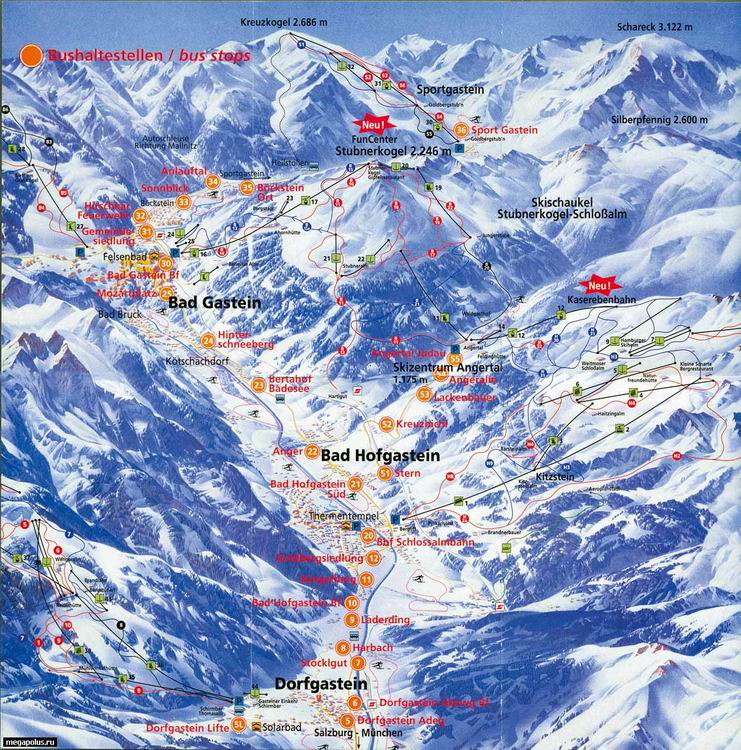 BAD GASTEIN – BAD HOFGASTEIN BAD GASTEIN – BAD HOFGASTEIN
Bad Gastein is a spa town in the Austrian state of Salzburg, situated at the northern rim of the Hohe Tauern national park. It has 5,838 inhabitants. The name "Bad" means "spa", reflecting the town's history as a health resort. It is located at the head of the Gastein valley, about 1,000 meters (3,280 ft.) above sea level. The townscape is characterised by historic multi-storey hotel buildings erected on the steep slopes.
Middle Ages. It was originally a gold mining area and the site of an ancient trade route crossing the Central Eastern Alps. In the 19th century the hot springs of Bad Gastein became a fashionable resort, visited by monarchs as well as the rich and famous. Some notable guests of the past included the Empress Elisabeth of Austria-Hungary (Sisi) , Iran's last king Mohammad Reza Pahlavi and the German Emperor Wilhelm I with his chancellor Otto von Bismarck. In 1865 Bismarck had signed the Gastein Convention with Austria concerning the administration of the provinces of Schleswig and Holstein after the Second Schleswig War. From the 1960s on the resort lost some its former notoriety and many former hotels sit empty. During the past few years, Bad Gastein renovated its Felsentherme and the Congress Center.
Spa and Therapy
The local Heilstollen (literally 'healing tunnel') thermal spring water earned the town its early fame. Theophrastus Parcelsus (1493-1541) had studied the spring water to discover its secrets. Marie Curie (1867-1934) and Heinrich Mache (1876-1954) helped to discover that it contained radon and as a result radon therapy began in the town.
Radon inhalation therapy at Gasteiner-Heilstollen began as a result of further investigation into the anecdotal experiences of silver miners who noticed improvements in symptoms from various ailments including arthritis.[citation needed] Ankylosing spondylitis (also known as Bechterew's disease), in particular, has seen positive results from treatment at the Heilstollen.However, there is very little empirical evidence of any benefit to inhaling radon. For example, one of the few studies to test the efficacy of spa treatments for Ankylosing spondylitis found no statistically significant difference between a group that spent three weeks at Bad Gastein and a group that spent three weeks at a different spa without radon inhalation therapy.
Places of interest
-Nikolauskirche (1380)
-Gletschermühlen
-Felsenbad
-Gasteiner Heilstollen
-Gasteiner Heimatmuseum im Haus Austria
 Activities Activities
Beside its water treatments, the town is popular for winter sports. It hosted the 1958 World Championships in alpine skiing. Bad Gastein also regularly is a scene of the snowboarding and boardercross worldcup.
Most of the Gastein Valley contains moderate to good skiing/snowboarding, with plenty of chairlifts and gondolas. Many establishments on the slopes offer warmth, food and strong drinks.
Traditions
Bad Gastein has vibrant pagan traditions that have been slightly assimilated into Roman Catholic tradition. One example of the pre-Christian Alpine traditions is the Krampus, now adopted as one of the Companions of Saint Nicholas. The Krampus is an elemental, horned and demonic character, playfully re-enacted by bands of male revelers during December and also once every four years during a Perchten event or Perchtenlauf. The Perchtenlauf happens every four years at Bad Gastein. The most recent was in January 2006.
 Transportation Transportation
The Gastein valley has connections to other parts of Austria via rail, road and identifiable cycle routes.
It is a stop along the Tauernbahn major railway line from Schwarzach-Sankt Veit in the north through the Tauerntunnel to Spittal an der Drau in the south, connecting Bad Gastein with many Austrian cities like Vienna, Linz, Salzburg and Graz along a single circuit. It is therefore easily accessible by the frequent EuroCity and InterCity trains going along this route.
The B167 Gasteiner Straße federal highway also passes right through the Gastein valley. Through traffic is simple from the northern entrance at Lend in the Salzach valley passing the municipalities of Dorfgastein and Bad Hofgastein. However, the continuation southwards to Mallnitz in Carinthia requires cars to roll onto a train for a short trip through the Tauerntunnel by motorail.
|















